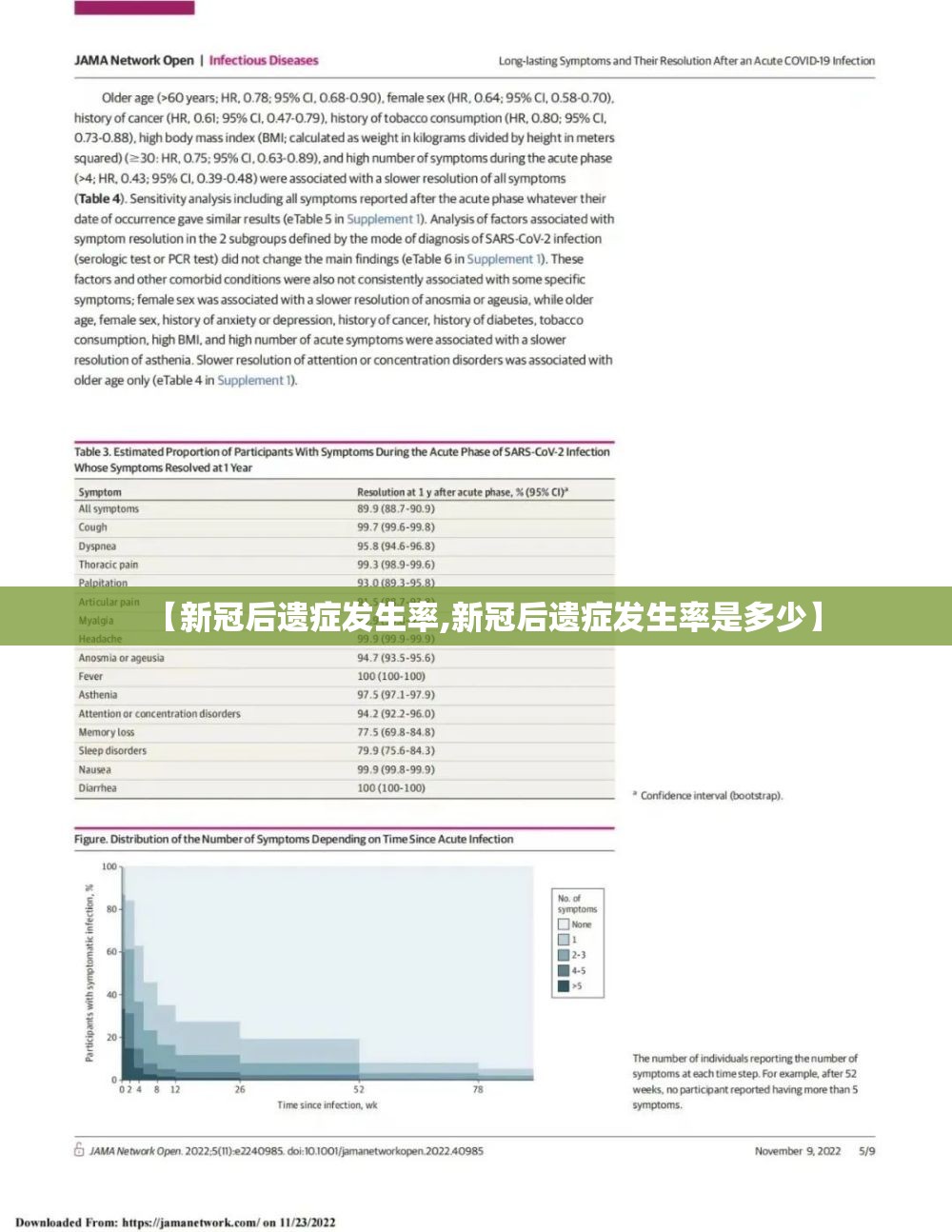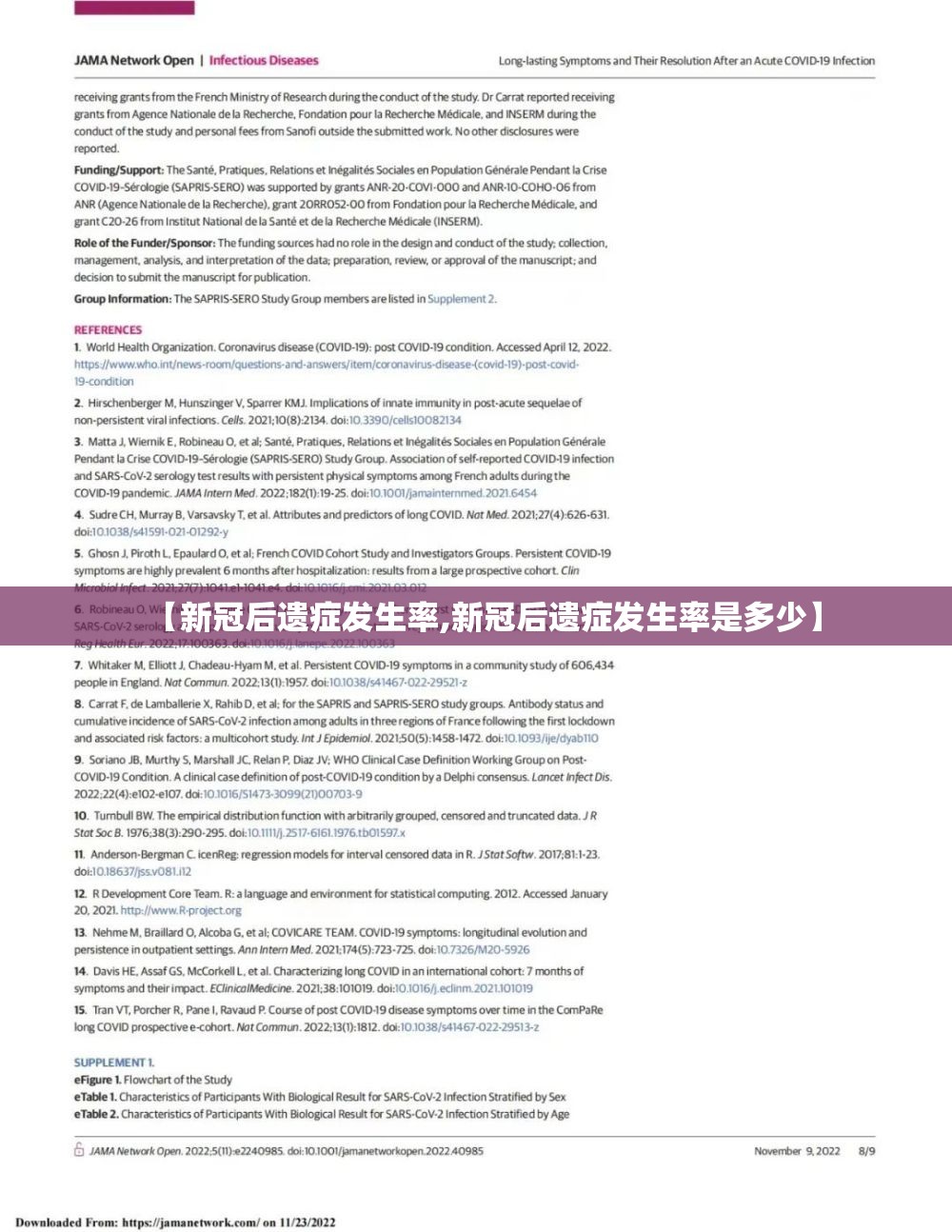新冠疫情自爆发以来,已席卷全球,造成数以百万计的死亡和感染,随着急性感染阶段的逐渐控制,一个更为隐蔽却同样严峻的问题浮出水面:新冠后遗症(Long COVID),后遗症的发生率成为科学家、医疗工作者和公众关注的焦点,它不仅影响着康复者的生活质量,还对医疗系统和社会经济构成长期挑战,本文将探讨新冠后遗症的发生率、影响因素以及可能的应对策略,以唤起对这一问题的更深入认识。
新冠后遗症,通常指感染新冠病毒后持续数周甚至数月的症状,包括疲劳、呼吸急促、认知障碍(如“脑雾”)、胸痛、关节痛等,根据世界卫生组织(WHO)的定义,这些症状在感染后3个月内出现,持续至少2个月,且无法用其他诊断解释,研究表明,新冠后遗症的发生率因人群、病毒变异株、疫苗接种状况等因素而异,但总体而言,它是一个不容忽视的普遍现象。
多项大规模研究揭示了新冠后遗症的发生率,一项发表于《自然》杂志的综述指出,约10-30%的感染者会经历某种形式的长期症状,轻症患者中后遗症发生率约为10-15%,而重症患者则高达50%以上,另一项由美国疾控中心(CDC)支持的研究显示,在成年感染者中,近20%的人报告了持续症状,这些数据表明,新冠后遗症并非罕见,而是影响广泛人群的健康问题。
新冠后遗症的发生率受多种因素影响,年龄和性别是重要变量,老年人和女性似乎更易出现长期症状,可能与免疫反应差异有关,初始感染的严重程度是关键因素:重症患者更可能面临后遗症,但轻症甚至无症状感染者也可能受到影响,疫苗接种被证明能显著降低后遗症发生率,英国健康安全局(UKHSA)的报告显示,接种两剂疫苗可将后遗症风险降低约50%,病毒变异株 also plays a role; for example, the Omicron variant is associated with a lower rate of long COVID compared to the Delta variant.
新冠后遗症的 impact extends beyond individual health. It poses a substantial burden on healthcare systems, as patients require ongoing care for multifaceted symptoms. Economically, it leads to reduced productivity and increased absenteeism, with some individuals unable to return to work. Socially, the invisible nature of long COVID often leads to misunderstanding and lack of support, exacerbating mental health issues such as anxiety and depression.
Addressing the challenge of long COVID requires a multi-faceted approach. Firstly, enhanced public awareness is crucial. Many people, including healthcare professionals, still underestimate the prevalence and severity of long COVID, leading to underdiagnosis and inadequate treatment. Educational campaigns and professional training can help improve recognition and management. Secondly, research investment must be increased to understand the underlying mechanisms, such as autoimmune responses or viral persistence, which could lead to targeted therapies. Currently, treatment is primarily symptomatic, focusing on rehabilitation and support.

Moreover, healthcare systems need to develop integrated care models for long COVID patients, involving multidisciplinary teams of physicians, physiotherapists, and mental health professionals. Countries like the UK have established specialized long COVID clinics, which could serve as a model for others. Additionally, policy support, such as sick leave provisions and disability benefits, is essential to alleviate the socioeconomic strain on affected individuals.
In conclusion, the incidence of long COVID is a significant and ongoing consequence of the pandemic, with rates ranging from 10% to 30% among infected individuals. It is influenced by factors like age, severity of infection, and vaccination status. While vaccines reduce the risk, the sheer number of infections globally means that millions are suffering from these lingering effects. As we move forward, a concerted effort from governments, healthcare providers, and communities is needed to support those affected and mitigate the long-term impact. Ignoring long COVID would not only be a disservice to survivors but also a missed opportunity to strengthen our resilience against future health crises.


发表评论
暂时没有评论,来抢沙发吧~